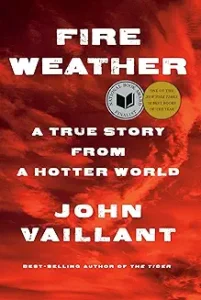Fire Weather: A True Story From a Hotter World by John Vaillant 2023
READ THIS BOOK! I’ve read 3143 books since I began to keep a Book Journal in 1978 and I’ve posted reviews of 800 of those since I went live with BookMarks. This book ranks in the top 5 of the most interesting, well-written, and vitally important books read during those years.
Vaillant, a Canadian award-winning writer, has written a remakable book. It focuses on the Fort McMurray fire of May, 2016. Fort McMurray is a city in north central Alberta 600 miles from the US border almost totally devoted to the bitumen extraction industry. At the time of the fire, it was sending 4 million barrels of oil/day to the US accounting for 50% of US oil imports. During four days in May, Fort McMurray went up in smoke destroying thousands of homes and burning the equivalent of 2000 square miles before it was contained 15 months later. The amazing stories of heroism and courage as this city of nearlky 90,000 was evacuated with almost no notice and with no loss of life are spell-binding as Vaillant slowly shares the details. He does this while also teaching the reader about the bitumen industry, about the physics of fire (It’s not the wood that burns, it’s the combustible gases that are released by heat.), about the WUI (woodland/urban interface that we are all living in today), and most importantly and urgently, about global warming and climate change.
The title of the book has a two-fold meaning. First, global warming has created enormous increases in what firefighters call ‘fire weather’, the combination of high record-breaking temperatures (It reached 90 degrees on May 1st as the McMurray fire was beginning.) and record low humidity (It reached the low teens as the day progressed.) is the perfect setting for out of control fires—one leg of the fire triangle of weather/fuel/topography. Second, fires like the McMurray one, the Redding, CA fire of 2018, and the fires in Australia in 2020 that destroyed 25% of the continent’s forests create their own weather with tornados, heat of greater than 2500 degrees, winds, and vortices that are capable of sucking semi-trailer trucks into the fire and turning a 3000 square foot home into ash in less than 3 minutes!
There are so many stories, facts, figures, and insights from Vaillant’s book that are worth sharing, but it’s two concepts that have stuck with me. First, is what he calls the Lucretius Problem, named after the 1st C Greek philosopher whose work was described by Stephen Goldblatt a few years ago in ‘The Swerve’. The Lucretius Problem refers to a difficulty in human perception described by Lucretius in his ‘De Rerum Natura’: “Yes, and so any river is huge if it be the greatest man has seen who has seen no greater before…and each imagines as huge all things of every kind which are the greatest of those he has seen.” Vaillant applies this to the situation in Fort McMurray as the fire began to become threatening: “Humans have difficulty in imagining and assimilating things outside their own personal experience. Hundredth-percentile fire weather conditions during the hottest, driest May in recorded history, following a two year drought in a sudden city filled with 25,000 petroleum-infused boxes (i.e. houses) and surrounded by millions of desiccated trees is something no Canadian firefighter or emergency manager had experienced.” And, hence, the failure to appreciate the coming catastrophe
The second concept is one taken from the US Senate’s 9/11 Commission report which declared, “The most important failure was one of imagination.” It is this failure of imagination, combined with the Lucretius Problem that has enabled world leaders and greedy corporate executives and shareholders to ignore climate change. Carbon dioxide and methane are invisible. Most of us do not live in fire weather areas or on Pacific Islands which are being submerged. We do not see wasted coral reefs every day. We do not see the hundreds, perhaps thousands of species which are becoming extinct every year. What we do see are the cars and trucks which the petroleum industry fuels and the auto industry manufactures with enabling funding from the US Government.
And this is where Vaillant’s writing is most powerful as he documents how science has been warning of global warming due to greenhouse gas emissions from burning fossil fuels for 150 years documenting the linear rise of temperature with carbon dioxide concentration in the atmosphere while the American Petroleum Institute and its Republican allies have been lying and distorting the science, and the planet heats up.
I could go on, but will simply urge you to read this book, one chose ans amongst the Top Five Nonfiction books of the year by the NYT. It’ worth every moment you spend on it.



